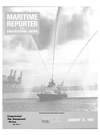
Page 31: of Maritime Reporter Magazine (January 15, 1985)
Read this page in Pdf, Flash or Html5 edition of January 15, 1985 Maritime Reporter Magazine
To help reduce fuel costs, GE's
Blended Fuel Testing Program is presently burning a blend of 50 percent #6 fuel with 50 percent #2 fuel in its new Engine Endur- ance Laboratory in Erie, Pa.
General Electric's recently in- troduced three-ring piston design significantly reduced lube oil con- sumption during field tests. This
GE design, using two compression rings and one oil control ring, also reduces ring wear for longer life between overhauls.
The development of GE turbo- chargers that operate more effec- tively in marine service has greatly improved acceleration characteris- tics and can further improve fuel efficiency. The projected life of connection rod bearings and their crankshaft journals has been in- creased with the development of a grooveless upper rod bearing half, while welded-in, stainless steel 30-degree value seats improve cyl- inder head life.
GEORGE ENGINE
Circle 11 on Reader Service Card
An undersea survival machine so efficient, its basic form hasn't changed for over 60 million years.
Powerful, tireless, capable of swimming at speeds up to 30 miles an hour At home in the shallows as well as in depths to 12,000 feet.
A sensory system that can smell infinitesimal traces of blood - and detect the thrashing of a wounded fish hundreds of yards away.
It is called shark, and it has no fear Because it has few enemies, save others of its kind.
The enormous amounts of oxy- gen required to fuel this powerful machine are supplied through one of nature's most remarkable pumps. Because sea water carries only 3/100ths as much free oxygen as air the shark's respiratory pump must move tremendous volumes.
Yet the water it pumps is 800 times denser than air
Controlling fluids is vital to the survival of a modern submarine as well. Its pumps must be designed and constructed so they operate not only efficiently, but silently. For its survival depends, in part, on detecting others while remaining undetected.
The unique ways in which
Ingersoll-Rand met the noise and reliability standards set by the U.S
Navy are the major reasons it was chosen as pump supplier for the Trident nuclear submarines.
For example, there is con- siderable potential for noise in the conventional, high-speed single impeller Ingersoll-Rand engineers substituted a staged series of small impellers that deliver the required flow while keeping rotation speed and fluid velocity low. And, inside the hydraulic passageways, vir- tually all noise-causing turbulence was eliminated by refining impeller vane geometry and spacing.
Our research goes on, to build more efficient pumps for both mili- tary and industrial uses. By fighting corrosion, by adding longer life and cutting maintenance, by moving greater volumes at higher speeds with less energy.
For more information, write Ingersoll-Rand Pump
Group, Dept. B-346, Washington,
New Jersey 07882.
Putting fluid technology to work.
INGERSOLL-RAND
PUMPS
As much as an 11.5-percent re- duction in fuel consumption can be realized by George Engine Com- pany's "bypass operation"—the upgrading of a Detroit Diesel 149 series engine from its normally as- pired (NA) configuration to a tur- bocharged, intercooled, blower-by- pass (TIB) configuration using tbe latest high-tech components from
Detroit Diesel. Fuel savings pro- vide a rapid payback of the cost of the conversion.
With a smaller fuel injector, the
TIB configuration produces the same horsepower at the same rpm as the NA arrangement, but does it with significantly less fuel. Al- ternatively, the owner may elect to use larger injectors to achieve greater horsepower output, but still at a competitively low specific fuel consumption figure.
ISOTTA FRASCHINI
Circle 12 on Reader Service Card
Isotta Fraschini S.p.A. is a com- pany of the VM Group, the diesel engine sector of Finmeccanica of
Italy. Isotta has been designing and building engines continuously since 1909. It is headquartered in
Saronna, about 15 miles from
Milan, with a second major facility located in Bari on the Adriatic
Sea.
Isotta designs and manufactures a broad range of diesel engines for diverse applications. The ID 32 en- gine series for marine propulsion has a power output range from 180 to 400 bhp at 2,700-3,000 rpm. The ID 38 series when used for marine propulsion is rated from 180 to 400 bhp at 2,700-2,900 rpm for workboat use, 500 bhp at 3,000 rpm in military applications. The
ID 36 engine type is rated 300- 1,320 bhp at 1,650-1,800 rpm for workboats, and up to 1,600 bhp at 1,900 rpm for military craft.
The ID 36 diesel engines are available in V-form models with six, eight, 12, and 16 cylinders; a 10-cylinder version is presently under development. All production engines in this series are available in amagnetic versions. Isotta also manufactures, under license, the
Paxman Diesel model PV2000 en- gine, which has a power range of 1,000-4,500 bhp at 1,600 rpm.
The ID 36 SS6 V-AM amagnetic engine is being supplied to the
U.S. Navy for its mine counter- measure ship program. This en- gine has a continuous power rat- ing of 660 bhp at 1,800 rpm for ambient temperature of 78 F; when derated for 100 F, output is 620 bhp at 1,800 rpm. Parallel opera- tion of two ID 36 SS6 V-AM en- gines into a common gearbox pro- vides a continuous output power of 1,320 bhp at 78 F ambient.
Cost of ownership/life cycle costs for the ID 36 SS6 V-AM engine is reduced through high reliability and time between overhaul, and low maintainability. Because the engine's magnetic signature is permanent, it never needs to be •<• Circle 110 on Reader Service Card

 30
30

 32
32
